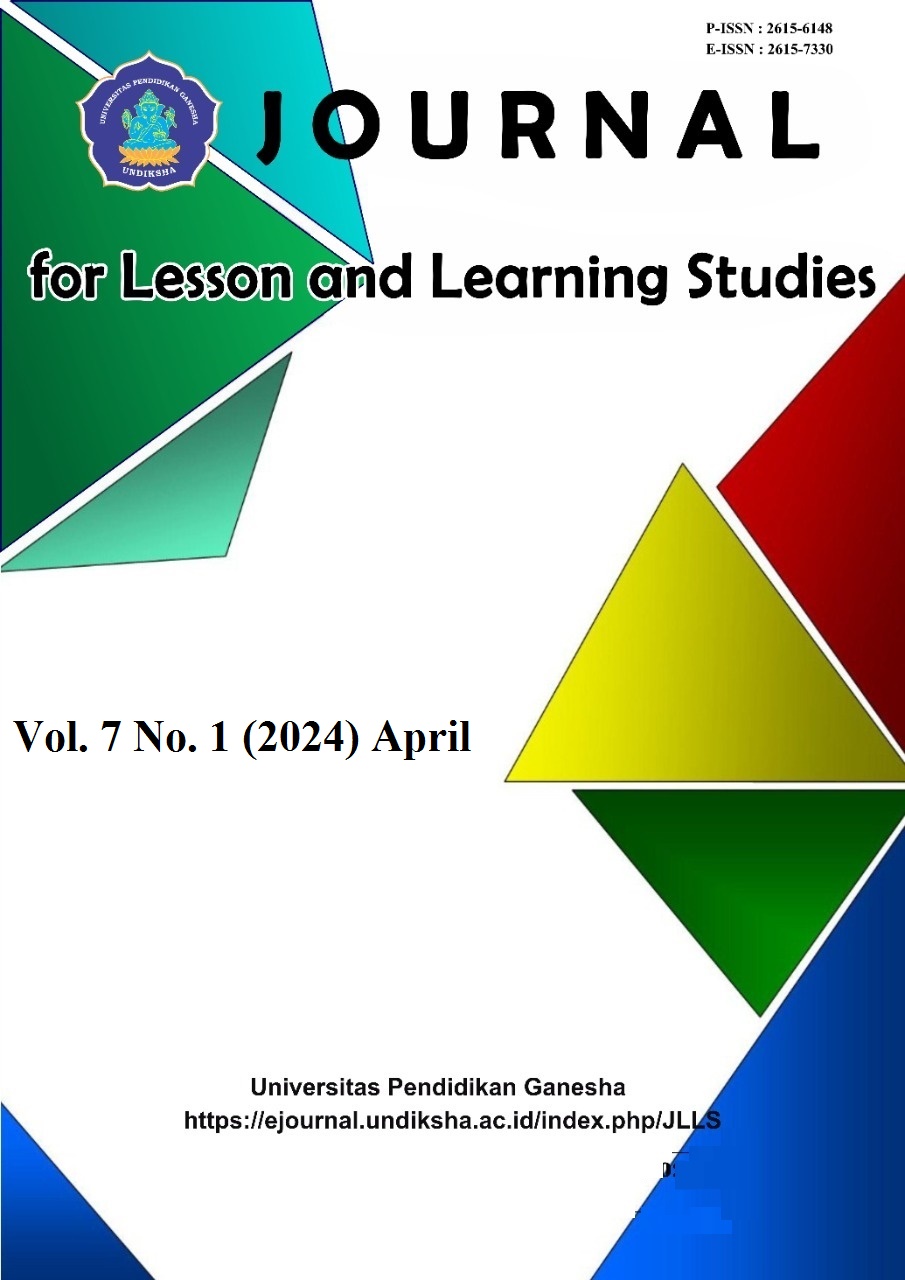Sorogan-Based Learning to Stimulate Early Counting Skills
DOI:
https://doi.org/10.23887/jlls.v7i1.74946Keywords:
Counting Skills, Sorogan, Student Worksheet, Mathematic’s LearningAbstract
Beginning counting ability is an important basic ability for students to be able to answer and understand further mathematical problems, including the introduction of numbers and basic mathematical concepts. The problem discussed here is an attempt to change the conventional teaching method (lecture) at the beginning counting learning stage towards a learning approach that can better facilitate children's learning needs and create meaningful learning. This study aims to analyze the application of the Sorogan method assisted by graded student worksheets (LKS) in stimulating student’s counting skills in Calistung class. The research method used is descriptive qualitative, with a case study approach. This research was conducted involving Calistung B class students consisting of 5 children as research subjects. The research techniques used were observation, interview, and documentation. The results showed that the Sorogan method assisted by graded worksheets was able to make a positive contribution in stimulating student’s beginning counting skills. Components such as initial apperception, practice problems, discussion, and reflection applied in Sorogan learning activities play an important role in supporting the formation of deep understanding. The student-centered learning process of the Sorogan method, which prioritizes a focus on exploring aspects of individuality, supported by the use of graded worksheets, gradually helps students understand numeracy concepts, thus becoming the foundation for the continuous development of numeracy skills. This method can be an alternative for educators to improve the quality of learning early counting.
References
Adedoyin, O. O., & L.A., C. (2018). Predictors of numeracy skills giftedness in young children: Perceptions of Botswana early childhood practitioners. African Educational Research Journal, 6(4), 218–227. https://doi.org/10.30918/aerj.64.18.080. DOI: https://doi.org/10.30918/AERJ.64.18.080
Afif, M. (2019). Penerapan Metode Sorogan dalam Meningkatkan Baca Kitab di Pondok Pesantren Tarbiyatun Nasyi’in. KABILAH : Journal of Social Community, 4(2), 34–43. https://doi.org/10.35127/kbl.v4i2.3592. DOI: https://doi.org/10.35127/kbl.v4i2.3592
Ahmad, A. B. (2021). Peran Media Sempoa Sebagai Alat Bantu Stimulasi Kemampuan Berhitung Siswa. Jurnal Pendidikan Dan Sains, 2(2), 341–353. https://ejournal.unzah.ac.id/index.php/alfikru/article/view/575.
Albab, U., Albab, M. U., Novitasari, Shodiq, J., & Salsabilah, A. T. (2022). Implementasi Metode Pembelajaran Sorogan Dan Bandongan Dalam Pengajaran Mata Pelajaran Pendidikan Agama Islam Di Sd Nu Banat Banin Lamongan. Akademika, 16(2), 19–30. https://doi.org/10.30736/adk.v16i2.1134. DOI: https://doi.org/10.30736/adk.v16i2.1134
Amelia, D. jantung, A.M., I. A., & Saputra, S. Y. (2020). Pengembangan LKPD Berorientasi Metakognisi Di SD Muhammadiyah 5 Bumiaji. JINoP (Jurnal Inovasi Pembelajaran), 6(1), 113–122. https://doi.org/10.22219/jinop.v6i1.7168. DOI: https://doi.org/10.22219/jinop.v6i1.7168
Aneka, Kurniasih, S., Hasanah, U., & Regiana, W. T. (2022). Penggunaan Permainan Kartu Angka Untuk Meningkatkan Pemahaman Berhitung Pada Anak Raudlatul Athfal. J-SANAK: Jurnal Kajian Anak, 3(2), 72–85. https://pdfs.semanticscholar.org/1476/402d04fc0d563ca40c7f958496a031bbb505.pdf. DOI: https://doi.org/10.24127/j-sanak.v3i02.992
Anwar, C. (2019). Metode Sorogan Dalam Pembelajaran Membaca Al-Qur’an di Pondok Pesantren. Mimbar Kampus: Jurnal Pendidikan & Agama Islam, 18(2), 149–166. https://doi.org/10.47467/mk.v19i2.432. DOI: https://doi.org/10.47467/mk.v19i2.432
Anwar, L. M., Jufri, A. W., & Muhaimi, L. (2019). Application of Madrasah Based Management in Improving the Quality of Aliyah Madrasah Education. International Journal of Multicultural and Multireligious Understanding, 6(5), 257. https://doi.org/10.18415/ijmmu.v6i5.1086. DOI: https://doi.org/10.18415/ijmmu.v6i5.1086
Aunio, P., & Räsänen, P. (2016). Core numerical skills for learning mathematics in children aged five to eight years – a working model for educators. European Early Childhood Education Research Journal, 24(5), 684–704. https://doi.org/10.1080/1350293X.2014.996424. DOI: https://doi.org/10.1080/1350293X.2014.996424
Fathonah, N., & Yudhawati, U. (2019). Peningkatan Aktivitas dan Hasil Belajar Siswa Melalui Model Problem Based Learning. UNION: Jurnal Pendidikan Matematika, 7(3). https://doi.org/10.30738/union.v7i3.5910. DOI: https://doi.org/10.30738/union.v7i3.5910
Fatimah, A. S., & Santiana, S. (2017). Teaching in 21St Century: Students-Teachers’ Perceptions of Technology Use in the Classroom. Script Journal: Journal of Linguistic and English Teaching, 2(2), 125. https://doi.org/10.24903/sj.v2i2.132. DOI: https://doi.org/10.24903/sj.v2i2.132
Fauzan, A., Purnamasari, A. I., Ajiz, A., Kaslani, & Tohidi, E. (2022). Media Pembelajaran Berhitung Berbasis Game dengan Metode Addie Untuk Meningkatkan Prestasi. Journal of Information System Research, 3(4), 351–357. https://doi.org/10.47065/josh.v3i4.1436. DOI: https://doi.org/10.47065/josh.v3i4.1436
Febriani, A., Utomo, H. B., & Dwiyanti, L. (2022). Pengembangan Dadu Hitung Edukatif Sebagai Media Untuk Menstimulasi Kemampuan Berhitung Anak Usia Dini. Jurnal Pelita PAUD, 6(2), 180–187. http://repository.unpkediri.ac.id/4800/. DOI: https://doi.org/10.33222/pelitapaud.v6i2.1667
Febrizalti, T., & Saridewi. (2020). Stimulasi Kemampuan Berhitung Anak Usia Dini melalui Metode Jarimatika. Jurnal Pendidikan Tambusai, 4(3), 1840–1848. https://doi.org/10.31004/jptam.v4i3.656.
Firda, J., Setiawani, S., & Murtikusuma, R. P. (2019). Analisis Kemampuan Komunikasi Matematis Siswa Peserta Calistung SMP Negeri 8 Jember. Kadikma, 10(1), 116–125. https://doi.org/10.19184/kdma.v10i1.11813.
Firdaus, F. A., & Mariyat, A. (2017). Humanistic Approach In Education According To Paulo Freire. At-Ta’dib, 12(2), 25. https://doi.org/10.21111/at-tadib.v12i2.1264. DOI: https://doi.org/10.21111/at-tadib.v12i2.1264
Hoffmann, G., & Pfeiffer, J. (2022). Gameful Learning for a More Sustainable World: Measuring the Effect of Design Elements on Long-Term Learning Outcomes in Correct Waste Sorting. Business and Information Systems Engineering, 64(4), 459–482. https://doi.org/10.1007/s12599-021-00731-x. DOI: https://doi.org/10.1007/s12599-021-00731-x
Isna, T. W., Putra, R., Wicaksana, T. I., Tasrif, E., & Huda, A. (2021). Peningkatan Hasil Belajar Siswa melalui Problem Based Learning (PBL). Jurnal Imiah Pendidikan Dan Pembelajaran, 6(1), 155–164. https://doi.org/10.23887/jipp.v6i1.42726. DOI: https://doi.org/10.23887/jipp.v6i1.31523
Jelatu, S., Yohanes, K., Valeria, S. K., Kanisius, M., & Ricardus, J. (2019). “Collaboration TPS Learning Model and M-Learning Based on Android for Understanding of Trigonometry Concepts with Different Cognitive Style.” International Journal of Instruction, 12(4), 545–60,. https://doi.org/10.29333/iji.2019.12435a DOI: https://doi.org/10.29333/iji.2019.12435a
Khofifah, S., & Ramadan, Z. H. (2021). Literacy conditions of reading, writing and calculating for elementary school students. Journal of Educational Research and Evaluation, 5(3), 342–349. https://doi.org/10.23887/jere.v5i3.37429.
Krismayani, ni wayan, Suastra, I. M., & Suparwa, i nyoman. (2021). Ecolinguistic Approaches in Development of English Teaching Materials for English for Business. E-Journal of Linguistics, 15(1), 16–24. https://doi.org/https://doi.org/10.24843/e-jl.2021.v15.i01.p03 Ecolinguistic. DOI: https://doi.org/10.24843/e-jl.2021.v15.i01.p03
Luthfiya, M. F. & D. (2017). metodologi penelitian; penelitian kualitatif, tindakan kelas & studi kasus. CV JEJAK.
Mirza, S., Mahmood, A., & Waqar, H. (2022). The interplay of open innovation and strategic innovation: Unpacking the role of organizational learning ability and absorptive capacity. International Journal of Engineering Business Management, 14, 1–15. https://doi.org/10.1177/18479790211069745. DOI: https://doi.org/10.1177/18479790211069745
Mulyasari, W., & Fahrozy, F. P. N. (2023). Pemahaman Konsep Pada Nilai Tempat Di Sekolah Dasar. Jurnal Elementaria Edukasia, 6(2), 442–452. https://doi.org/10.31949/jee.v6i2.5295. DOI: https://doi.org/10.31949/jee.v6i2.5295
Mustofa, A., & Muadzin, A. (2021). Konsepsi Peran Guru Sebagai Fasilitator dan Motivator Dalam Proses Pembelajaran Pendidikan Agama Islam. Jurnal Pendidikan Islam, 7(2), 171–186. https://doi.org/10.37286/ojs.v7i2.102. DOI: https://doi.org/10.37286/ojs.v7i2.102
Padallingan, Y. (2022). Identifikasi Cara Guru Mengajar Siswa Membaca, Menulis, Berhitung (Calistung) Pada Masa Pandemi di Kelas 1 SDN 213 Inpres Lemo. Jurnal Keguruan Dan Ilmu Pendidikan, 11(1), 13–19. https://doi.org/10.47178/jkip.v11i1.1614. DOI: https://doi.org/10.47178/jkip.v11i1.1614
Rachmadtullah, R., Yustitia, V., Setiawan, B., Fanny, A. M., Pramulia, P., Susiloningsih, W., Rosidah, C. T., Prastyo, D., & Ardhian, T. (2020). The Challenge of Elementary School Teachers to Encounter Superior Generation in the 4.0 Industrial Revolution: Study Literature. International Journal of Scientific and Technology Research, 9(4), 1879–1882. https://www.researchgate.net/profile/Reza-Rachmadtullah/publication/340886839.
Rahayu, N. (2018). Pembelajaran Calistung bagi Anak Usia Dini. Aṭfālunā: Journal of Islamic Early Childhood Education, 1(2), 53–58. https://doi.org/10.32505/atfaluna.v1i2.922. DOI: https://doi.org/10.32505/atfaluna.v1i2.922
Retnowati, P., & Ekayanti, A. (2020). Think Talk Write Sebagai Upaya Meningkatkan Komunikasi Matematis Siswa. Sigma, 6(1), 17. https://doi.org/10.36513/sigma.v6i2.863. DOI: https://doi.org/10.36513/sigma.v6i2.863
Saidah, K., Primasatya, N., Mukmin, B. A., & Damayanti, S. (2021). Sosialisasi Peran Apersepsi untuk Meningkatkan Kesiapan Belajar Anak di Sanggar Genius Yayasan Yatim Mandiri cabang Kediri. Dedikasi Nusantara, 1(1), 18–24. https://doi.org/10.29407/dedikasi%20.v1i1.16065. DOI: https://doi.org/10.29407/dedikasi.v1i1.16065
Sari, N. M. A., & Manuaba, I. B. S. (2021). Development of Interactive E-Module Based on Human Digestive System Material Inquiry on Theme 3 About Healthy Foods for Fifth Grade Elementary School. Indonesian Journal Of Educational Research and Review, 4(1), 54. https://doi.org/10.23887/ijerr.v4i1.33297. DOI: https://doi.org/10.23887/ijerr.v4i1.33297
Setyaningsih, L., & Ekayanti, A. (2019). Keterampilan Berfikir Siswa SMP dalam Menyelesaikan Soal Matematika Ditinjau dari Kemampuan Number Sense. Jurnal Didaktik Matematika, 6(1), 28–39. https://doi.org/10.24815/jdm.v6i1.11699. DOI: https://doi.org/10.24815/jdm.v6i1.11699
Sukmawati, T. N., Husna, N., & Wahyuni, R. (2021). Analysis of Problem Solving Ability Judging from the Ethnicity of Junior High School Students on Social Arithmetic Materials in Singkawang City West Kalimantan. Jurnal Kependidikan: Jurnal Hasil Penelitian Dan Kajian Kepustakaan Di Bidang Pendidikan, Pengajaran Dan Pembelajaran, 7(4), 968–980. DOI: https://doi.org/10.33394/jk.v7i4.3920
Sulthon. (2018). Peningkatan Kualitas Pembelajaran Melalui Pendekatan Konstruktivistik Dalam Pendidikan Bagi Anak Usia Dini. ThufuLA: Jurnal Inovasi Pendidikan Guru Raudhatul Athfal, 1(1), 135–152. https://doi.org/10.21043/thufula.v1i1.4250. DOI: https://doi.org/10.21043/thufula.v1i1.4250
Sumaji, S., & Wahyudi, W. (2020). Refleksi Pembelajaran Matematika SMK Muhammadiyah 1 Ponorogo Pada Materi Persamaan dan Pertidaksamaan Linear Mutlak. Jurnal Cendekia : Jurnal Pendidikan Matematika, 4(2), 746–755. https://doi.org/10.31004/cendekia.v4i2.281. DOI: https://doi.org/10.31004/cendekia.v4i2.281
Suprapto, A. A. (2020). Pembelajaran Membaca Menulis Dan Berhitung (CALISTUNG) Pada Kelompok TK B USIA 5-6 Tahun Di KB SURYA MARTA. Jurnal Pendidikan Anak Usia Dini, 9(9), 53–61.
Supriatna, A., & Ediyanto, E. (2021). The Implementation of Multisensory Technique for Children with Dyslexia. IJDS: Indonesian Journal of Disability Studies, 8(01), 279–293. https://doi.org/10.21776/ub.ijds.2021.008.01.17. DOI: https://doi.org/10.21776/ub.ijds.2021.008.01.17
Susdarwono, E. T. (2020). Penguasaan 4 (Empat) Prasyarat Dasar Aritmatika Untuk Meningkatkan Kemampuan Siswa Sekolah Dasar Dalam Menyelesaikan Soal Matematika. Jurnal Pembelajaran Dan Matematika Sigma (Jpms), 6(2), 72–84. https://doi.org/10.36987/jpms.v6i2.1856. DOI: https://doi.org/10.36987/jpms.v6i2.1856
Susi, M., & Umi, K. (2022). Peningkatan Kemampuan Berhitung 1-10 Melalui Video Animasi Pada Kelompok A Di RA AR Rohmah Pekukuhan Kecamatan Mojosari Kabupaten Mojokerto. Abata : Jurnal Pendidikan Islam Anak Usia Dini, 2(2), 241–249. https://doi.org/10.32665/abata.v2i2.883. DOI: https://doi.org/10.32665/abata.v2i2.883
Tokmak, H. S., Baturay, H. M., & Fadde, P. (2013). Applying the context, input, process, product evaluation model for evaluation, research, and redesign of an online master’s program. International Review of Research in Open and Distance Learning, 14(3), 273–293. https://doi.org/10.19173/irrodl.v14i3.1485. DOI: https://doi.org/10.19173/irrodl.v14i3.1485
Tomaszewski, L. E., Zarestky, J., & Gonzalez, E. (2020). Planning Qualitative Research: Design and Decision Making for New Researchers. International Journal of Qualitative Methods, 19, 1–7. https://doi.org/10.1177/1609406920967174. DOI: https://doi.org/10.1177/1609406920967174
Valentina, A., & Wulandari, M. D. (2022). Media Pembelajaran Mabeta Untuk Menguatkan Kemampuan Berhitung Peserta Didik Sekolah Dasar. Jurnal Cakrawala Pendas, 8(3), 601–610. https://doi.org/10.31949/jcp.v8i3.2474. DOI: https://doi.org/10.31949/jcp.v8i3.2474
Vargas-Hernández, J. G., & Vargas-González, O. C. (2022). Strategies for meaningful learning in higher education. Journal of Research in Instructional, 2(1), 47–64. https://doi.org/10.30862/jri.v2i1.41. DOI: https://doi.org/10.30862/jri.v2i1.41
Winarno, A., Fedin, M. Y. A., & Salleh, N. H. M. (2022). the Effect of Technological Literacy, Learning Facility, and Family Environment on Students’ Learning Motivation. Jurnal Pendidikan: Teori, Penelitian, Dan Pengembangan, 7(7), 246. https://doi.org/10.17977/jptpp.v7i7.15404. DOI: https://doi.org/10.17977/jptpp.v7i7.15404
Wirabumi, R. (2020). Metode Pembelajaran Ceramah. Annual Conference on Islamic Education and Thought, I(I), 105–113. http://pkm.uika-bogor.ac.id/index.php/aciet/article/view/660.
Yuliana, N., Purwati, N., & Hanapi, H. (2022). Improving student’s logical thinking abilities and learning outcomes through guided inquiry model. Prisma Sains: Jurnal Pengkajian Ilmu Dan Pembelajaran Matematika Dan IPA IKIP Mataram, 10(2), 345–351. https://doi.org/10.33394/j-ps.v10i2.4822. DOI: https://doi.org/10.33394/j-ps.v10i2.4822
Yusuf, M., Subagya, M., I., & Budiarto, M. K. (2022). Implementation of PBL and IBL Models Assisted by Video Media to Improve Critical Thinking Skills. Jurnal Ilmiah Sekolah Dasar, 6(3), 375–384. https://doi.org/10.23887/jisd.v6i3.47949. DOI: https://doi.org/10.23887/jisd.v6i3.47949
Downloads
Published
How to Cite
Issue
Section
License
Copyright (c) 2024 Osfir Candikia Rara Komara, Sumaji, Wahyudi, Ahmad Azzam Al Qoyyimuddin

This work is licensed under a Creative Commons Attribution-ShareAlike 4.0 International License.
Authors who publish with the Journal for Lesson and Learning Studies agree to the following terms:
- Authors retain copyright and grant the journal the right of first publication with the work simultaneously licensed under a Creative Commons Attribution License (CC BY-SA 4.0) that allows others to share the work with an acknowledgment of the work's authorship and initial publication in this journal.
- Authors are able to enter into separate, additional contractual arrangements for the non-exclusive distribution of the journal's published version of the work (e.g., post it to an institutional repository or publish it in a book), with an acknowledgment of its initial publication in this journal.
- Authors are permitted and encouraged to post their work online (e.g., in institutional repositories or on their website) prior to and during the submission process, as it can lead to productive exchanges, as well as earlier and greater citation of published work. (See The Effect of Open Access)




